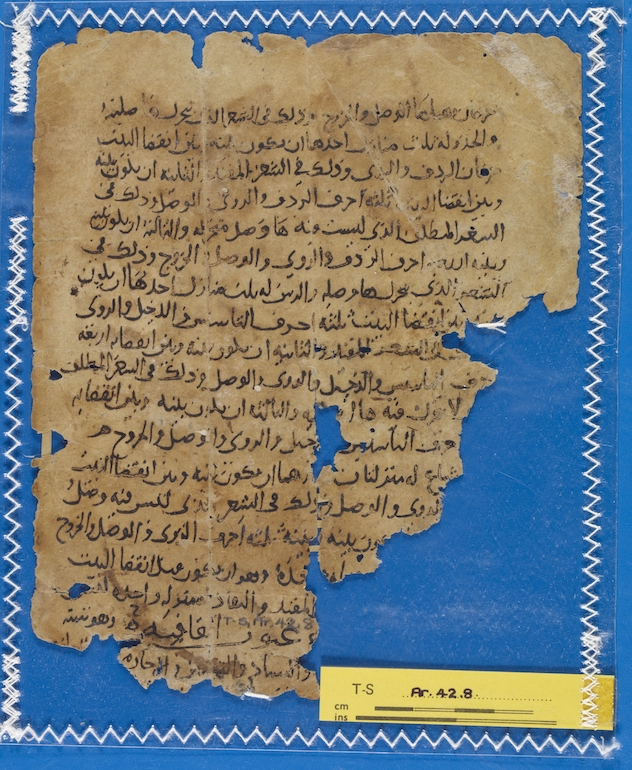Q&A Wednesday: Arabic poetic literature with Mohamed Ahmed

Hi Mohamed, which manuscript are you working on today?
I’m working on T-S Ar.42.8. It’s a fragment in Arabic script by an unidentified author and scribe.
Can you tell me about it?
It’s a fragment of a work on poetics, covering the subject of prosody in Classical Arabic poetry and mentioning famous Arabic poetic scholars, such as al-Ḵalīl and al-Aḵṭal. The recto focuses on prosody in Classical Arabic poetry, and the verso focuses on vowel marks (Ḥarakāt) in Arabic script. A verse by al-Aḵṭal is given as supporting evidence for the author’s argument. Unfortunately, the beginning of the discussion is missing from the fragment.
It looks like it’s a page from a book - have you found any other pages of the book or other copies of this text?
I haven’t found any other similar pages (so far), but it seems to be a page from a book dedicated to poetry and Arabic grammar in general. It is interesting to find such fragments in the Genizah collection. It not only tells us, in general, about the poetic anthologies and literature that was read and in circulation among Jewish community in Medieval Egypt at the time, but also tells us about the scholarly activities at the time and theories on poetry itself.
Has anyone else studied this fragment before, or are you the first to look at it in detail?
It has previously been mentioned briefly in two publications, which just state that it is a work on Arabic poetics. So far, it seems that the fragment has not received adequate attention.
Can you tell me how this manuscript fits in with your current research project?
The fragment is very important to the part of my Arabic Poetry in the Cairo Genizah project, which studies Arabic poetry in light of literacy and education. We are investigating what Arabic poetry fragments can tell us about Arabic literature shared within the Jewish community in Egypt, shedding light on an unexplored facet of Jewish cultural identity at the time. We aim to investigate the history of literacy and education of the Jewish community from the 13th century until the Ottoman Empire. Being Arabic speakers, Jews in the medieval Egypt were naturally familiar with Arabic literature. There is a considerable number of Arabic books that have been transcribed into Hebrew script in various genres. Therefore, fragment T-S Ar.42.8, and the like, are significantly important to the project. This fragment will tell us about theories and scholarly literature that were known to Jewish readers of the time.
Is there anything that surprises you or particularly captures your attention about T-S Ar.42.8?
I’m enjoying studying this fragment as it is quite different to other fragments we are looking at for the project. Most of the other fragments focus on poems on different themes, but few fragments deal, as T-S Ar.42.8 does, with prosody and poetry criticism. It is a good opportunity to understand the literary scholarship of the time. And because this fragment comes from a Jewish context, though it is in Arabic script, we can see Jews reading, enjoying, and sharing the same literary experience as their non-Jewish neighbours. For anyone interested in Arabic poetry of the period, such sources are of great importance.
Thanks Mohamed - I will let you get back to T-S Ar.42.8 now.

Add new comment